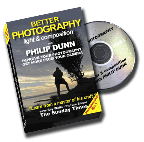
Do you have a wide angle lens but rarely take it out of your camera bag? I reckon a wide angle is one of the most useful lenses you can own for everything from landscapes to portraits… it just needs treating with a bit of respect and understanding.
A wide angle lens is not just to get ‘more in’. There, I’ve said it again - something I bang on about to my students every time we talk about short focal length lenses. A lens with a focal length equivalent to about 24mm is perhaps the most useful because it has the effect of accentuating the perspective of your pictures without distorting things too much. Yes, I know there are people who would argue that it does nothing of the sort, but I was careful to say ‘has the effect of’. It has the effect of making the foreground appear nearer and the background further away because it captures more in the frame, and yes, I suppose it is useful for getting ‘more in’ when you are taking pictures in confined spaces.
The most obvious effect of this accentuated perspective is to add a greater illusion of depth, or the third dimension, to your two dimensional photographs.
The perspective of the bridge and the boats has been exaggerated with a 24mm lens to ensure that the eye is led right into the picture. The swans, of course, are the focal point, but the overall effect makes the viewer feel as though he could clamber out over the boats
Lenses equivalent to a focal length of less than 24mm start to have considerable distorting effect. I rarely use them for this reason. The shorter the focal length, the wider the angle of the lens, and the greater the distortion. Pictures taken purely for the effect of a super wide, or fish-eye lens have become a cliché and unless you have specific purpose for such a lens you are unlikely to get much use from it. However, a 24mm or perhaps 28mm equivalent can be extremely well employed for a great range of subjects. For landscape, townscape and interior shots in particular the 24-28mm equivalent lens is indispensable. I say ‘equivalent’ because you have to remember that unless your digital SLR has a full-frame sensor – and most digital SLRs do not – there is a magnification factor of around 1.6. So you need a lens with an actual focal length of around 15mm to get the ‘equivalent’ of a 24mm.
This time a 21mm wide angle lens has been used to gather extra information into the picture. This man is a saddler and I wanted to show what he was doing and the sort of tools he used to do it. The tools were carefully arranged in the near foreground and he was asked to stand back just a little and reach forward. This has added to the effect of extra depth by making his hands look slightly bigger so that he seems to be coming further out of the picture
20 Dec 2007
Wide angle lens - Part 1
Yes, a wide angle lens can be used to ‘get more in’ and it really come in handy with interior shots. I would have been unable to include the entire room in this photograph without a 24mm lens. This lens has already started to distort the settee a little. Had I used an even shorter focal length lens, I would have got ‘even more in’, but the distortion would have been unacceptable. Notice how I have been able to include the flowers in the foreground to create a pleasant atmosphere. By stopping down to a small aperture, the already considerable depth of field of the wide angle lens has been boosted even more. Those flowers are just three feet away from the camera, yet they and the background are perfectly in focus
Next, in Part 2 - wide angles and converging verticals
Subscribe to:
Post Comments (Atom)



1 comment:
amazing information. Can't wait to read part 2.
I want to incorporate fashion and style with street photography.
You have just brought me one step closer.
Post a Comment